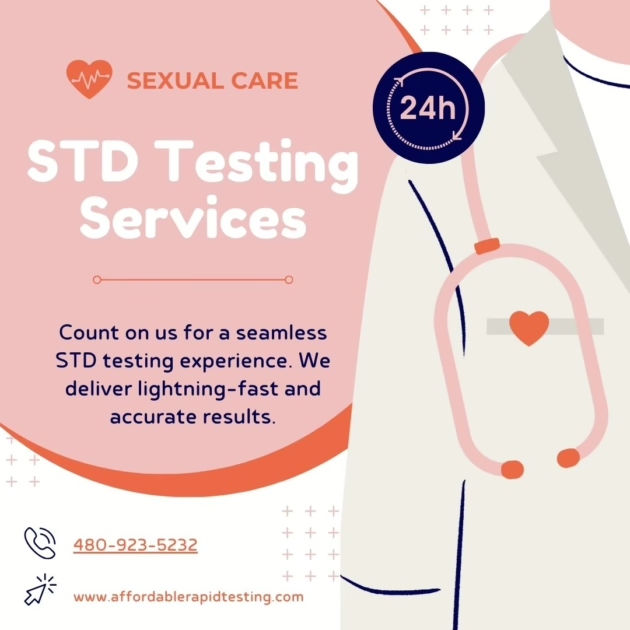Sexually transmitted diseases (STDs) are infections that spread through various types of sexual contact, and with over 1 million new cases reported daily worldwide, they are a major public health concern. Understanding how STDs spread—whether through sexual activities or, in rare cases, non-sexual means—plays a vital role in protecting yourself and your partners.
Since many of these infections can be present without showing symptoms, regular STD testing is essential. It allows for early detection and effective treatment, helping prevent the spread of infections.
Remember that staying informed about the modes of STD transmission and getting tested for STDs regularly are key steps in maintaining sexual health and safety.
What Are STDs?
Sexually transmitted diseases (STDs) are infections primarily spread through sexual contact, including vaginal, anal, and oral sex. Common STDs include chlamydia, gonorrhea, syphilis, herpes, and HIV.
These infections can lead to various health issues, from mild discomfort and sores to severe conditions like infertility and immune system damage.
Some STDs, like Herpes and HIV, are lifelong conditions that require ongoing management. Early detection and treatment are crucial to prevent complications and reduce transmission.
How STDs Spread
STDs can be transmitted through various means, making it essential to understand the different ways they can spread:
Sexual intercourse:
- Vaginal sex: The most common mode of transmission, where infections can spread through the exchange of bodily fluids.
- Anal sex: Often carries a higher risk due to the delicate nature of the anal tissues, which are more prone to tears.
- Oral sex: Can transmit infections like Gonorrhea, Syphilis, and Herpes, particularly if there are sores or cuts in the mouth.
Skin-to-skin contact:
STDs like Herpes and HPV can be transmitted through direct skin-to-skin contact, even without sexual penetration. This can happen when infected areas, such as sores or warts, come into contact with a partner’s skin.
Non-sexual transmission:
Although rare, some STDs can be spread through non-sexual means. For example, Trichomoniasis can occasionally be transmitted through shared moist items like towels, clothing, or bedding that have been in contact with infected genital secretions. This mode of transmission is less common but still possible, especially in environments where hygiene is compromised.
How STDs Spread Via High-Risk Behaviors
Certain behaviors increase the risk of contracting and spreading STDs. Here are some of the key high-risk behaviors:
- Multiple sexual partners: Having multiple sexual partners increases chances of exposure to various infections, as the risk of encountering an infected individual rises with more partners.
- Lack of protection and contraceptive use: Not using condoms or other barrier methods during sexual activities significantly raises the risk of STD transmission. Condoms are effective in reducing the spread of infections, but when they are not used consistently or correctly, the chances of contracting STDs increase.
- Sharing needles: Sharing needles, syringes, or other equipment for intravenous drug use can transmit bloodborne infections such as HIV and Hepatitis. Even a small amount of infected blood can carry a high risk of infection.
STD Transmission Myths
There are plenty of myths about how STDs spread, which can lead to confusion or unnecessary worry. Let’s clear up a few of the common ones:
Kissing: Risks and Misconceptions
Many people wonder if kissing can transmit STDs. While it’s pretty low-risk, there are a few exceptions, like herpes, which can spread if there are cold sores present. But don’t stress—most other STDs don’t pass through a simple kiss.
Two Condoms: Why Layering Is Ineffective
You might think that using two condoms at once would double the protection, but it’s actually the opposite. The friction between the two condoms can make them more likely to break. So, stick to one properly used condom for the best protection.
Being STD-Free: Risks of Assuming Partners Are STD-Free
It’s easy to assume that someone doesn’t have an STD, especially if they don’t show any symptoms. But many STDs can be present without any signs. The only way to know for sure is through testing. Don’t skip protection based on assumptions—it’s better to be safe than sorry.
Preventing STD Transmission
Taking steps to prevent STDs is all about being smart and proactive. Here’s how you can stay safe:
- Safe sex practices: Always use condoms and dental dams during sex. They’re easy to use and one of the best ways to protect yourself and your partner from infections.
- Regular STD testing: Make it a habit to get tested regularly, especially if you have multiple partners or are starting a new relationship. You can search for “confidential STD testing near me” or visit an “STD testing specialist” or “walk-in STD clinic” to make sure you’re on top of your health.
- Open communication: Don’t be shy about talking to your partner about sexual health. Honest conversations can help you both feel secure and informed about protection and testing.

Stop the Spread. Get Tested. Avail Top-Notch STD Testing Service From ART, Arizona
Understanding how STDs spread and taking proactive measures can significantly impact your sexual health. Practicing safe sex, getting tested regularly, and having open conversations with your partner are essential steps in preventing the transmission of STDs. If you’re looking for quick, reliable, and affordable testing, Affordable Rapid Testing, Arizona is your go-to option.
Affordable Rapid Testing in Arizona is here for you. They offer confidential STD testing with experienced STD testing specialists at their walk-in STD clinic where you will find a variety of STD tests and other comprehensive testing services.
Don’t wait—take control of your health today and get tested for STDs at one of the many convenient locations near you.


